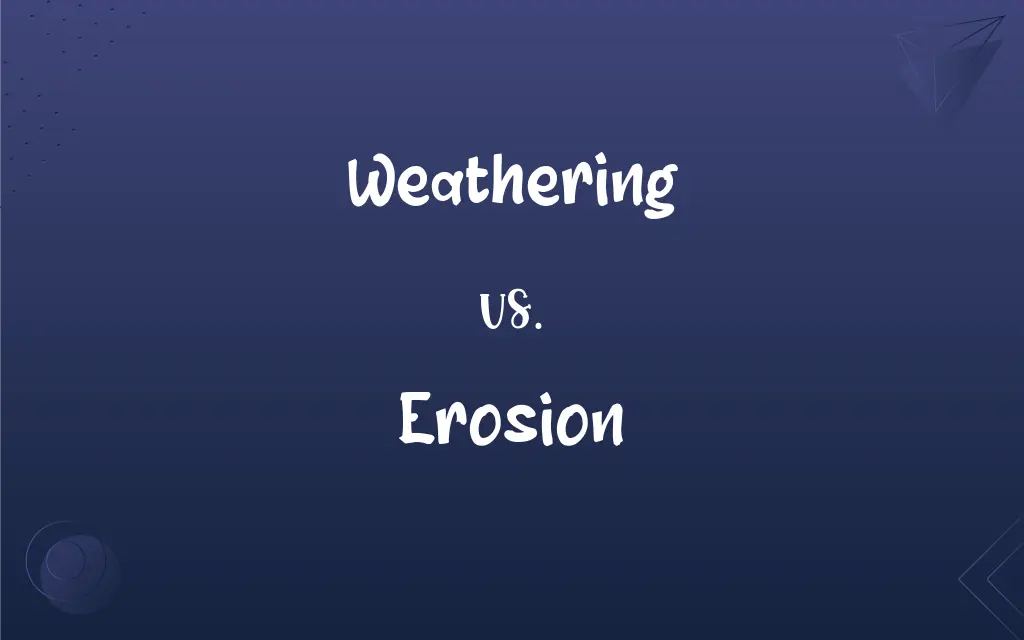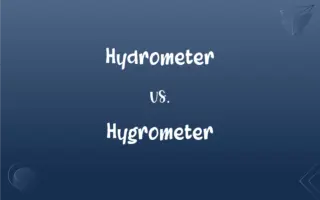Weathering vs. Erosion: What's the Difference?
Edited by Aimie Carlson || By Harlon Moss || Updated on October 24, 2023
Weathering breaks down rocks and minerals at their original place, while erosion involves the movement of these materials to a new location.

Key Differences
Weathering pertains to the process by which rocks, minerals, and soils break down over time due to natural elements like water, wind, and temperature fluctuations. Erosion, on the other hand, involves the transportation or movement of these broken-down materials from one location to another, primarily by agents like water, wind, and ice.
Both weathering and erosion play pivotal roles in shaping Earth's landscapes. While weathering changes the composition or structure of materials at their original location, erosion ensures these materials are relocated, forming new landscapes, valleys, and coastal features. For instance, mountains can be weathered by the freeze-thaw action of water, while erosion could carry away the resulting debris to form deltas or beaches.
It's essential to understand that weathering is the precursor to erosion. Before materials can be transported (erosion), they first need to be broken down (weathering). So, in a sequence, weathering generally occurs before erosion. However, erosion can accelerate weathering processes, especially when moved materials collide and break further.
Weathering processes can be chemical, physical, or biological. Chemical reactions, for instance, can alter a rock's mineral composition. In contrast, erosion primarily focuses on the physical relocation of these materials. As these processes occur side by side, they continuously reshape the Earth's surface, influencing ecosystems and human habitats.
Comparison Chart
Definition
Breakdown of rocks and minerals.
Movement of broken-down materials.
ADVERTISEMENT
Agents
Water, wind, temperature, biological activity.
Water, wind, ice, gravity.
Location
Occurs in place.
Transports materials from one location to another.
Sequence in Geologic Time
Generally precedes erosion.
Follows after weathering.
Result
Changes in composition or structure.
Formation of new landscapes, valleys, and coastlines.
Weathering and Erosion Definitions
Weathering
The natural process of rock breakdown.
Acid rain can accelerate the weathering of limestone structures.
ADVERTISEMENT
Erosion
The displacement of materials from their original position.
Wind erosion in deserts can lead to sand dune formation.
Weathering
A transformation of materials due to environmental factors.
The constant exposure to sea spray causes weathering on cliff faces.
Erosion
The process of moving soil and rock by natural agents.
Coastal erosion has reduced the size of the beach over the years.
Weathering
A change in mineral or rock properties.
Granite undergoes weathering, turning into clay over time.
Erosion
A geological phenomenon resulting in landscape changes.
The hills experienced erosion due to deforestation.
Weathering
The effect of atmospheric conditions on surfaces.
The tombstone's lettering faded due to weathering over the centuries.
Erosion
The wearing away of Earth's surface.
The river's continuous flow caused erosion, creating a canyon.
Weathering
The decomposition of Earth's surface materials.
Weathering has caused the ancient statues to lose their sharp details.
Erosion
The removal of surface layers through external forces.
The erosion of topsoil from farmlands impacts agriculture.
Weathering
Any of the chemical or mechanical processes by which objects exposed to the weather are worn or broken down.
Erosion
The group of natural processes, including weathering, dissolution, abrasion, corrosion, and transportation, by which material is worn away from the earth's surface.
FAQs
Are weathering and erosion interconnected?
Yes, weathering often precedes erosion, with broken-down materials subsequently moved by erosion.
What primarily causes weathering?
Weathering is primarily caused by natural elements like water, wind, temperature changes, and biological activity.
Which process is responsible for the formation of valleys and coastlines?
Erosion is responsible for forming valleys, coastlines, and other landscape features.
What are the main agents of erosion?
The primary agents of erosion include water, wind, ice, and gravity.
Which process can be chemical, physical, or biological?
Weathering can be chemical, physical, or biological.
Why is understanding these processes important for land management?
Understanding weathering and erosion helps in land conservation, infrastructure planning, and predicting landscape changes.
How does erosion differ from weathering in terms of movement?
While weathering breaks down materials in place, erosion involves the transportation of these materials to a new location.
Is weathering solely a destructive process?
While weathering breaks down materials, it's essential for soil formation and nutrient cycling.
Can human activities accelerate weathering and erosion?
Yes, activities like deforestation and construction can increase weathering and erosion rates.
How does biological weathering occur?
Biological weathering occurs due to living organisms, like plant roots breaking through rocks.
Is erosion a fast or slow process?
Erosion can be both fast, as in landslides, or slow, as in the gradual wearing away of coastlines.
How does weathering affect monuments and historical structures?
Weathering can lead to the decay, discoloration, or structural weakening of monuments and historical structures.
Can erosion benefit ecosystems?
Yes, erosion can create new habitats, redistribute nutrients, and form features like deltas that support biodiversity.
Does weathering occur uniformly on all rocks?
No, weathering rates vary depending on rock type, environmental conditions, and exposure.
Does weathering always lead to erosion?
Not necessarily, but weathered materials are often susceptible to erosion.
How does ice contribute to erosion?
Glaciers, a form of ice, can erode landscapes by scraping and carrying away large amounts of material.
Are there any positive human interventions against erosion?
Yes, practices like terracing, reforestation, and building retaining walls can mitigate erosion effects.
Can erosion be prevented?
While erosion can't be entirely prevented, its effects can be managed or reduced through conservation practices.
What's the outcome of chemical weathering?
Chemical weathering alters a rock's mineral composition through reactions with environmental agents.
How does wind lead to erosion?
Wind can pick up and transport loose particles, especially in arid regions, leading to erosion.
About Author
Written by
Harlon MossHarlon is a seasoned quality moderator and accomplished content writer for Difference Wiki. An alumnus of the prestigious University of California, he earned his degree in Computer Science. Leveraging his academic background, Harlon brings a meticulous and informed perspective to his work, ensuring content accuracy and excellence.
Edited by
Aimie CarlsonAimie Carlson, holding a master's degree in English literature, is a fervent English language enthusiast. She lends her writing talents to Difference Wiki, a prominent website that specializes in comparisons, offering readers insightful analyses that both captivate and inform.































































